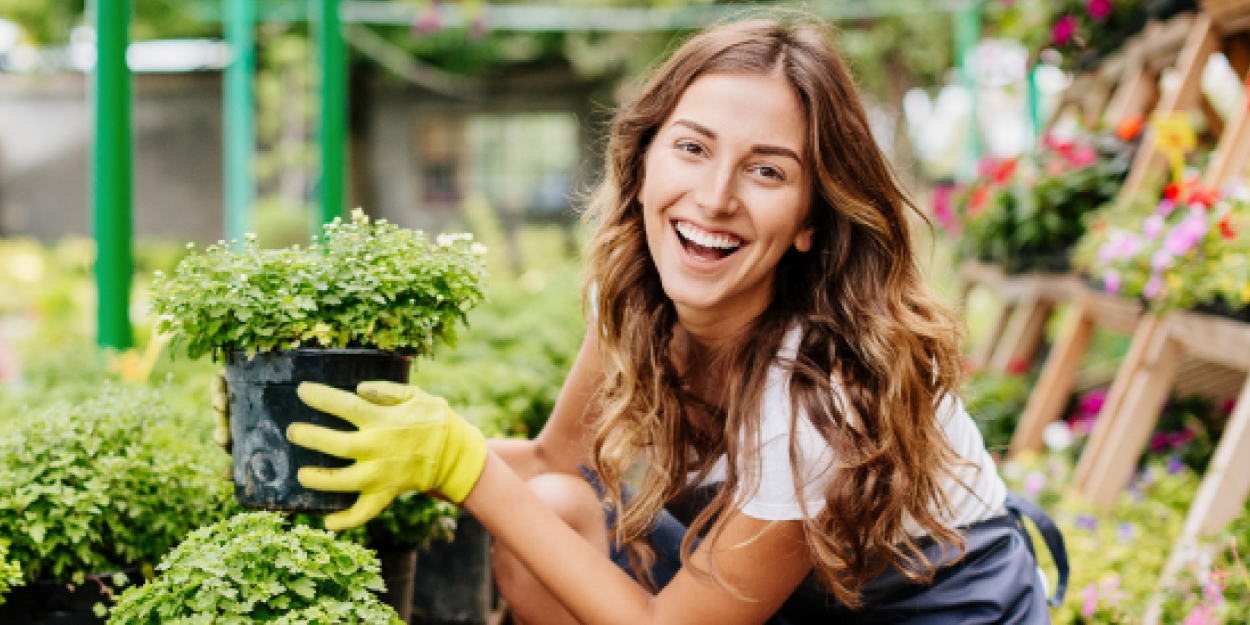Growing Peppers in Pots & Containers at Home
May 21st, 2021 | Categories
Growing lovely, sweet peppers at home in pots and containers is a great way to grow a good crop of fresh peppers to enjoy over the growing season. What makes it even better is that it is a straightforward process, and the versatility a container or pot offers means that you can place them indoors if you do not have a greenhouse or the outside weather conditions they need to grow. Peppers need extraordinarily little attention too once established, they will grow and produce throughout the growing season quite happily. Peppers are tropical and so do require a lot of sun and consistent warmth to crop well – if they don’t get this they will often fail and die – but we’ll cover that in greater detail later to keep you on the right track.
Sweet peppers are immensely popular for their versatility, nutrients, and flavour. Another name for sweet peppers is Capsicum, Capsicum annum to be precise, which is the same species as most commonly grown hot chillies. So why aren’t sweet peppers hot like chilli peppers you ask. Well, sweet peppers do not have the compound called capsaicin, which produces heat measured in chilli peppers by the Scoville scale. Different chilli pepper varieties have different levels of the compound, so they have different heat scores, whereas sweet peppers come in at 0 or close to it. Peppers are also fruits like tomatoes, because they come from a plant, despite being used like a vegetable in our meals. Just a little pepper trivia for you to store away for a far-off pub quiz.
Growing sweet peppers at home in containers and pots is very straightforward for experienced and new gardeners alike. Usually, once they are established and planted, they need extraordinarily little attention from you. But, with some more care and attention, they’ll really flourish. In this guide we will focus on growing from seed, which does require a little more effort, but rest assured it is all very uncomplicated, and quite rewarding. If you’re looking for an easy to follow and informative guide to tell you all that you need to know to grow sweet peppers in containers and pots at home – like bell peppers – then look no further. If you have a greenhouse, you can also refer to our guide for growing peppers at home in a greenhouse here. Let’s get started!
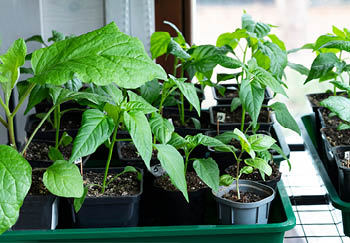
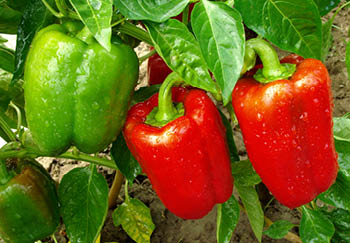
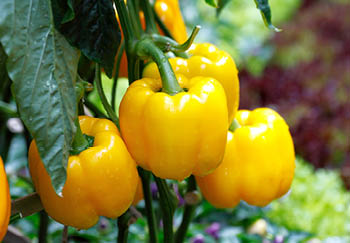
Why Grow Peppers in Containers & Pots?
Growing peppers in containers & pots is a great way to grow them if you don’t have a fully sunny space in the garden, or a greenhouse, maybe you have no garden at all, or maybe you are in a part of the UK that doesn’t get the weather conditions necessary. Whatever your situation, container grown peppers offer a versatility and some advantages than trying to grow in the ground. The biggest advantage is that they can be moved more easily to sunnier and warmer spots when needed or shielded from adverse weather conditions that our summers can bring. But why grow peppers fresh? Well, like most fruit and veg in the supermarket the sweet peppers we buy are grown with a focus in longevity at the expense of things like flavour.
They’re also subject to numerous pesticides, fertilisers and chemicals to ensure a successful crop. All done from a commercial point of view. So, growing at home, is hands down better for you and you’ll produce healthier, nicer tasting sweet peppers too. It’s also more economical and should work out cheaper for you in the medium to long run. Constantly buying peppers in the supermarket isn’t cheap. If you’re an avid pepper purchaser then calculate how many you buy over the course of a year and it might surprise you. A single plant cared for well should produce up to 20 peppers, some produce more. Just be sure to have a container or pot (or multiples) that will let it grow to a good size to produce for you.
Another great point is the variety for you to choose from. There are more sweet peppers out there than the eponymous green, yellow or red bell peppers you see in supermarkets. There are a variety of different types with their own colours, shapes, sizes and unique flavours. But even if you simply want to grow your own fresh bell peppers at home, we can guarantee a noticeable flavour difference. You’ll get more of the goodness too. Peppers are full of vitamins A and C, potassium, folic acid, and are a source of fibre. They’re also very easy to grow and suffer from less diseases than other vegetables. With so many good reasons it’s hard to come up with counters not to give growing them a go!
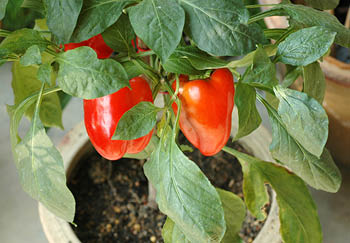
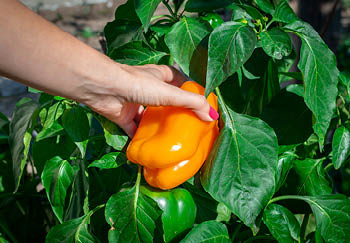
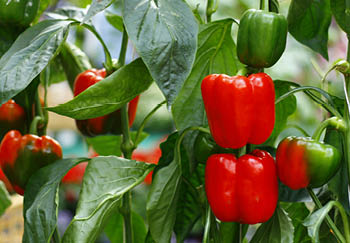
What Variety of Peppers Should You Grow in Containers?
It’s probably really nice and sweet bell peppers you want to grow, but if you want to explore other specific options for colour, shapes, or flavours, you can. There are a few varieties of sweet peppers to choose from. All of these can be grown in containers easily:
Corno di Toro Rosso
Long, pointy red peppers that can grow up to 20cm long. They can also be harvested when they are green. They have a lovely full flavour that’s sweet and crisp.
Redskin
A dwarf pepper variety producing short stumpy peppers but with good yields. Also produced well on a windowsill or in a conservatory.

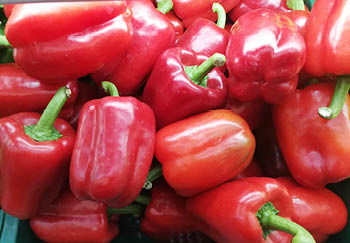
How to Start Growing Peppers in Containers
Now you know a bit more about peppers you’re almost ready to get started growing your own at home in containers or pots. It pays to know what to do in advance so read through our guide first. We’ll take you through growing from seed to harvest but you can also grow from young plants which are available from any good garden centre when in season. More on that next.
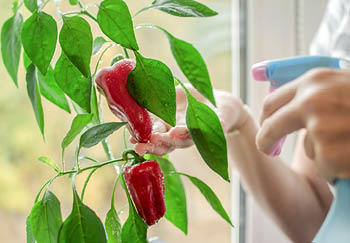
Growing Peppers in Containers from Young Plants
If you don’t want to go to the trouble of sowing your own seeds, there’s another way. You can simply buy varieties as young plants from any good garden centre when in season. The great thing about this is the effort to cultivate young seedlings has been done for you. All you do is plant them in their containers – how good is that! However, it is super easy to grow from seed and doesn’t take much effort at all. We encourage you to try! If you do opt for purchasing young plants, you can skip the sections with information on growing from seed below.
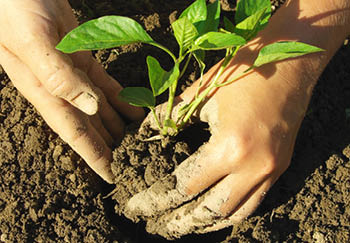
Growing Peppers from Seed
Starting off from seed? Good on you! You can buy most seed varieties throughout the year. However, the best time to start sowing your seeds will be indoors from as early as January if the conditions are right. Rest assured it does not take much effort and can be quite rewarding starting at this stage.

What You Will Need
Before you begin, gather these items. If you don’t have them then investing in them for future gardening projects will be more than worth it:
Pepper Seeds
Purchase the sweet pepper varieties you wish to grow in your containers.
The Right Spot
Pepper are tropical fruits and so to really thrive they will need to be grown somewhere warm and sunny. Many areas of the UK are not consistently warm enough for a long enough period which shortens their growing season. If you just go for it and plant outdoors, it can affect the final harvest, or provide none at all, so they really need the consistent warmth indoors can provide. You can move then outdoors in summer when you are sure the weather is good. Then, if the temperature dips they can be moved indoors again. To clarify though, cared for correctly peppers do not need to be outdoors at all, and you could go through the entire growing season with them in containers indoors.
Starter Pots or Containers
You’ll need some small starter pots or containers to grow your seedlings in. Options for use are cheap and widely available. In terms of the amount if you want a plentiful harvest, you’ll have to grow multiple plants.
Heat Mat or Propagator
The seeds should sit somewhere warm (above 20°C) with lots of sun, like a sunny windowsill in a warm room. You’ll be starting the process off in January so it might be hard to keep a room above the ideal temperature consistently which will slow things down. To really help get things going we advise purchasing a heat mat or propagator, both can be picked up cheaply, and this will ensure things move along well into the year as the temperatures begin to rise.
Larger Containers or Pots
When your seeds have grown into seedlings, or young plants, they’ll have to be transplanted to larger containers. They’ll need extra room to grow to establish a root network so they can produce lovely, sweet peppers for you. They’ll need to have a depth of at least 15cm, ideally something like 30cm. In terms of width, it depends, you could have a large square or rectangular container which would allow multiple plants to be planted, or multiple pots, allowing only one plant per pot. As a general rule, make sure they have at least 15cm – 20cm of distance from each other, and that will help you work it out.
Compost
A good quality multi-purpose vegetable compost will do the trick and provide lots of nutrients while your seeds and plants grow.
Fertiliser
Because they are container grown, there will be less nutrients available than there would be in the ground, so a good quality high-potash fertiliser will really help. Any vegetable or tomato fertiliser should do the job nicely.

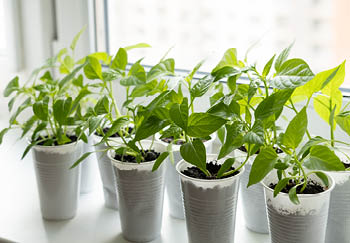

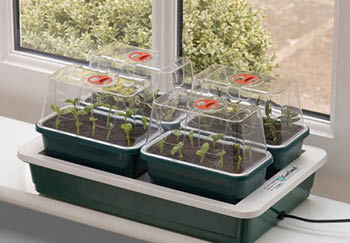
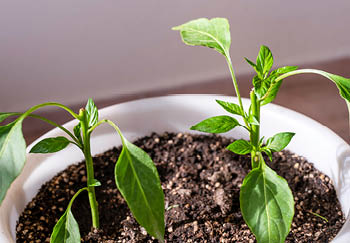
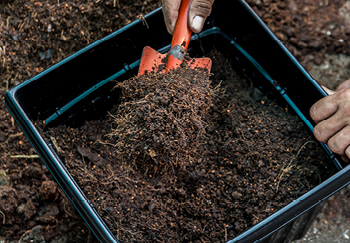
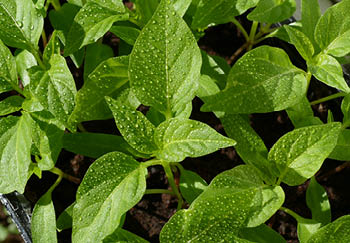
General Growing/Harvesting Timescale for Peppers
The general growing season for peppers is from January to September. Peppers need a long growing season and from seed you will start the process off sometime in January so long as you can meet the right conditions. This depends on you being able to keep them warm consistently, so if you cannot give them what they need naturally, then a heat mat/propagator is a necessary purchase. Otherwise, you may need to wait until ambient temperatures are much warmer, depending on where you are in the UK. You can sow seeds up until early April, but it means your peppers won’t be ready for harvest until later in the season.
Starting the process off early means you could have peppers producing as soon as late May or June depending on the varieties you are growing too. So, consider all the factors and get a good idea of your plan ahead of time. Another positive bonus of container grown peppers indoors is that you can get started sooner, and even extend the growing season so long as you continue to take care of them giving them the warmth and nutrients they need.
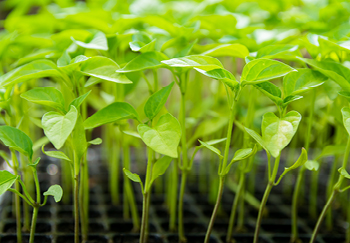
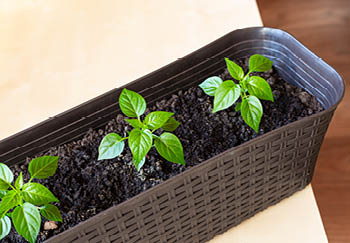
Sowing Seeds & Growing Seedlings
So, by now you have got your seeds, small pots, ideally have a propagator/heat mat and great sunny position in the house, as well as your containers and compost. First thing, fill your starter pots with the compost right to the top, and place a seed in each to a depth of about 5cm. Give them a water but only to make the soil moist, not overly wet, place the pots on your heat mat or in your propagator, and leave them in position. For the longest growing season, you will ideally do this around January/early February.
The next job is to keep the soil lightly moist with consistent watering over the coming days. You’ll notice little sprouting seedlings from 8 – 10 days later. Though if it takes a little longer don’t worry, they’ll appear. Top tip, as the seedlings appear, if you keep the soil on the drier side, it will encourage the roots to develop more. Continue to care for them until they are approximately 2cm – 3cm tall. This is your signal to transplant them to their final containers to fully grow and produce lots of lovely peppers. Bear in mind also to only transplant to their pots when ambient nightly temperatures exceed 10°C.
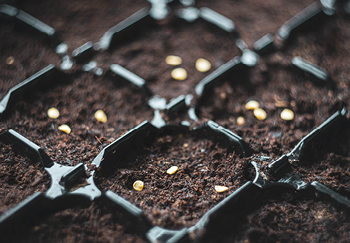
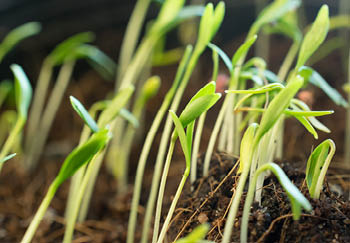
Transplanting Your Seedlings
Now your seedlings can be moved to their final containers. How exciting! First consider your spot, and if you can move the filled containers or pots easily. If you cannot do this because they are too large and heavy, then considering your spot becomes even more important. Peppers need warmth and lots of sunshine to really thrive. Consider a spot where they can get a minimum of six hours of sun daily and where the ambient temperature is warm.
In a good UK summer, they could be grown outdoors in the soil in a sheltered position that still gets lots of sun. To be honest though, we know that our summers can be unpredictable. This fact, combined with pepper’s needs of warmth and sun, means more realistically, they’re not going to be placed outdoors. Pepper plants are also quite delicate, so if there are heavy summer rains they can damage or even kill them. When you go to transplant the seedlings, gently dig them out of their starter containers or pots, and place them in their final spots, approximately 15cm apart. Planting them together does help, but you don’t want them too close that they can’t expand and take in lots of good nutrients to grow.
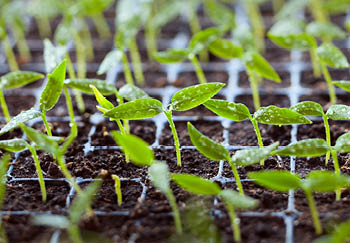
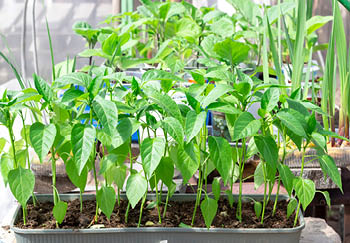
Actively Growing & Ongoing Care
Once planted in their containers, they require extraordinarily little attention. Watering is the primary thing the pepper plants will need. The soil needs to be moist but never water-logged. Aim to be consistent with your watering and do it little and often to prevent problems. Top tip: some pepper plant varieties can grow tall, above 70cm, and as peppers form, they can sag under the weight. Watch out for this ahead of time and stake them to provide support they need to keep growing and producing. Planting in containers means they have less space to expand, so they probably won’t reach this size. Additionally, once you see the first peppers form you can add in some high-potash fertiliser that will further aid their growth and make a great crop over the growing season.
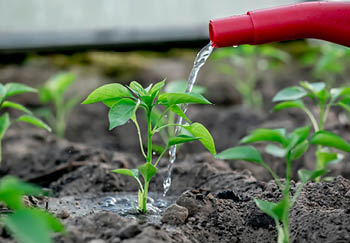
Harvesting Your Sweet Peppers
Your peppers should be ready for harvest sometime between July and September, perhaps even as late as October if the conditions can be maintained. You are free to pick them when they’re green or leave them to ripen to their final red or yellow colour (depending on the variety grown) which will also give them a sweeter flavour. Another key sign of when they are ready for picking is the skin; it will be shinier. Pick with a knife or secateurs to avoid damaging the plant. Once peppers are harvested give your plants another feed with a high-potash fertiliser to encourage more peppers.
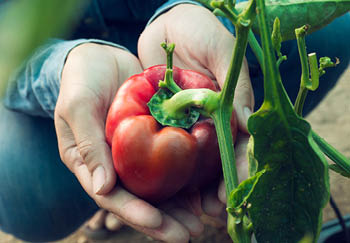
Storing Your Peppers
You can’t really store peppers although they can be frozen. They’ll keep for a few days in the fridge too. However, your best bet is to pick and eat when they are fresh. They’ll be delicious. Some peppers are well suited to being dried and then chopped or made into powders.
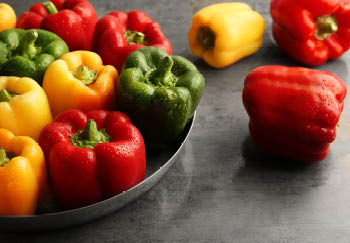
Common Pepper Problems
Like any plant and crop, peppers can suffer from some problems. Having said that, they are typically problem-free and planting in containers indoors should mean that you have more control over them. Here’s what to watch out for though:
Red Spider or Two-Spotted Mite
Pests like these will appear in hot, dry conditions, so misting plants regularly while also watering will keep things under control. They’ll be visible as the leaves will become mottled and pale, and covered in webbing on which the crawlies will be clearly visible.
Aphids
Aphids
You probably won’t get these, but you might be unlucky and get Aphids settling on your pepper plants. However, as most of us maintain strict no fly control zones in our homes and indoors generally it’s unlikely these will be an issue.
Blossom End Rot
This is likely your biggest issue when it comes to growing peppers in containers or pots. You’ll know you have blossom end rot will when darker spots appear on the ends of your plants and spoil them. Watering irregularly will cause this so as detailed earlier water little and often, so the soil does not dry out.
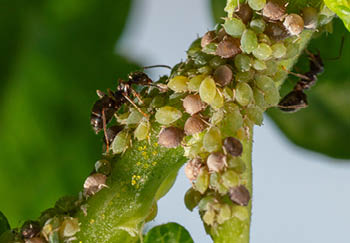
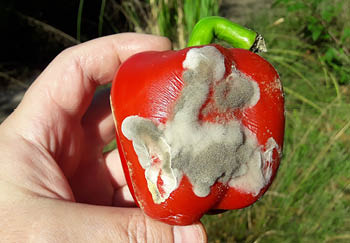
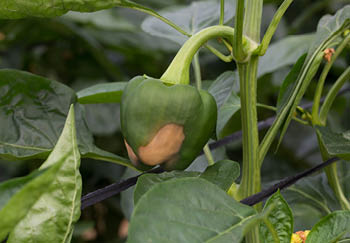
Your Own Home Grown Sweet Peppers to Enjoy
Bet you didn’t think it would be this easy, right? Or that the peppers themselves would be so much tastier grown fresh in your containers? Like we said, peppers are one of the easiest plants to grow when you meet their needs. Your plants will crop throughout their growing season allowing you to pick when ripe for a quick wash and a chop right into your summer salads. Why not chuck some over to the neighbours too for good neighbourly vibes. Just remember, in winter the plants will die, but now you have the process and necessary tools, you can get started again when January rolls around.

Useful Links
- Shop Online for Seeds & Bulbs
- Growing Peppers from Seed to Harvest (Article)
- Growing Tomatoes from Seed to Harvest (Article)
- Growing Carrots from Seed to Harvest (Article)
- Growing Onions from Seed to Harvest (Article)
- Growing Potatoes from Planting to Harvest (Article)
- Growing Chillies from Seed to Harvest (Article)
- Grow Your Own Herbs (Article)
- Grow Your Own Strawberries (Article)




